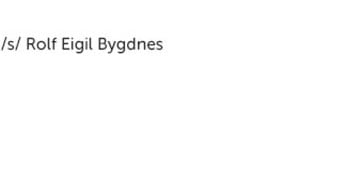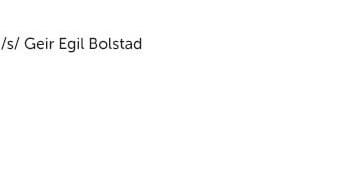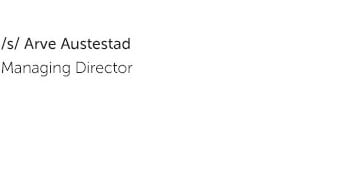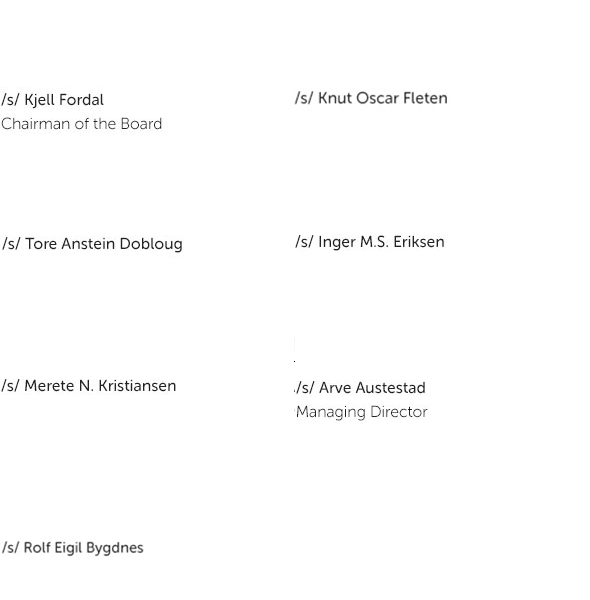Boligkreditt Annual Report 2018
Statement of the board of directors
Cover pool and outstanding covered bonds
SpareBank 1 Boligkreditt’s (‘Boligkreditt’, ‘SpaBol’, or ‘The Company’) cover pool consists of residential mortgages and liquid, highly rated assets as well as derivatives hedging liabilities in a foreign currency and/or at fixed rates. The chart below illustrates the balances as of year-end 2018:
1The source is the balance sheet figures as of 31 December 2018 and the cover pool asset liability test for overcollateralization (see notes to the financial statements). Norwegian covered bond issuers are by law obligated to group derivatives not together with the issued bonds that they hedge, but as part of cover pool assets. This is reflected in the chart and figures above.
The amount of liquid assets varies over time and the variation is solely a result of the Issuer’s liquidity risk management (and regulatory requirements), whereby upcoming redemptions are refinanced early with proceeds held as liquid assets (please see the investor reports for details on the composition of liquid assets). Derivatives are used solely to hedge currency and interest rate risk. The table below describes the mortgages in the cover pool:
Key figures overview
| Q4 2018 | Q3 2018 | Q2 2018 | Q1 2018 | Q4 2017 | |
|---|---|---|---|---|---|
| Weighted Average Current LTV (%) | 52.7 % | 51.7 % | 51.3 % | 52.4 % | 52.4 % |
| Weighted Average Original LTV (%) | 59.6 % | 59.8 % | 59.8 % | 59.9 % | 59.8 % |
| Average Loan Balance (NOK) | 1,422,929 | 1,414,203 | 1,414,916 | 1,400,686 | 1,386,865 |
| Number of Mortgages in Pool | 129,209 | 129,791 | 129,057 | 129,173 | 127,927 |
| Pct. of non first-lien mortgages | 0,0 % | 0,0 % | 0,0 % | 0,0 % | 0,0 % |
| Overcollateralization | 6.5 % | 6.5 % | 6.7 % | 6.7 % | 6.4 % |
Key developments in Q4 and full year 2018
Overall issuance in 2018 was approximately NOK 31 billion, across NOK, EUR and GBP (currency swapped values) which was similar to the prior year total issuance figure. Two benchmarks were issued in EUR for a total of EUR 2 bn, one issue in GBP and the rest in NOK.
The residential mortgage lending volume at SpaBol has increased moderately as expected by approximately 3.6 per cent during to the year, as measured against the balance of loans as of December 31, 2017. The current mortgage balance is 184 billion kroner (equivalent to approximately EUR 20 billion). One Alliance bank, SR-bank, has continued to decrease its loan volume in the cover pool and is below 5 per cent of the overall pool and Boligkreditt equity share as of year-end 2018. Other banks have increased their transferred volumes. The largest mortgage volume is provided by SpareBank 1 Østlandet at 22 per cent of the pool, followed by SpareBank 1 SMN at 21 per cent and SpareBank 1 Nord Norge at 18.
Boligkreditt is well capitalized with a capital coverage ratio of 16.8 per cent. The capital requirement is 15.5 per cent (Pillar 1), in addition to the Pillar 2 requirement of 0.8 per cent common equity. Total Tier 1 capital is 14.7 and common equity capital 13.1 per cent, the latter against a requirement for common equity capital (incl. Pillar 2) of 12.8 per cent. It is the Company’s policy to maintain a capital ratio slightly above the regulatory requirement. Additional common equity is injected by the owner banks when required, usually in connection with increases in transferred mortgage volume, while Additional Tier 1 and Tier 2 capital is issued in the Norwegian domestic market.
Boligkreditt has updated the Shareholders Agreement in 2018, reflecting the commitment of the shareholder banks (SpareBank 1 Alliance banks) to maintain the Tier 1 equity capital ratio at the current regulatory level in place from time to time, this was increased from the previous wording of 9 per cent. Shareholder banks contribute equity capital when sufficient additional volumes of mortgages are transferred to the cover pool. This Shareholder Agreement commitment, while never in practice applied, is a mechanism whereby the shareholders underline continued financial support for the issuer (details presented in the Programme Prospectus).
Nature and development of the Company’s business
SpareBank 1 Boligkreditt AS is a credit institution licensed by the Norwegian Financial Supervisory Authority (Finanstilsynet) and is operated according to the legislation for covered bond issuers in Norway which is included in the law regarding financial enterprises (“Finansforetaksloven”) chapter 11, section II and the detailed regulations thereof.
The purpose of the Company is to provide funding for the owners by buying residential mortgage loans with a loan-to-value (“LTV”) of up to 75 and financing these primarily through the issuance of covered bonds 3. The Company which is based in Stavanger, is owned by banks which are members of the SpareBank 1 Alliance. A comprehensive agreement is signed with each of the banks in the SpareBank 1 Alliance which are selling mortgages to the Company regarding the purchasing process and the obligations which the banks owe the Company and its mortgage customers (“Transfer and Servicing Agreement”, “TSA”). The Company pays out nearly the full margin earned to the owner banks which sell mortgages to the Company to obtain funding. This margin is accounted for as commissions due to owner banks and is included in the interest expense line of the Company’s financial statements with additional detail in the notes.
The Company’s issuances of covered bonds mainly take place under the EUR 25,000,000,000 Global Medium Term Covered Note Programme (GMTCN Programme). This Programme was updated on June 6, 2018 and is available on the Company's home page: https://spabol.sparebank1.no.
One or more credit ratings from international rating agencies are important in order to be able to issue covered bonds. The Company have procured the services of Moody’s Ratings Service to evaluate the credit quality of the issuances under the GMTCN Programme. The covered bonds rating is Aaa from Moody’s.
3 The limit for instalment mortgages are 75 per cent, while mortgages which have no scheduled repayment structure are limited to 60 per cent (these are a smaller portion of the mortgage portfolio). All mortgages above 60 per cent must be amortizing by at least 2.5 per cent per year according to current mortgage market regulations.
Annual accounts
The quarterly accounts have been prepared in accordance with the International Reporting Standards (IFRS) as adopted by the EU and published by the International Reporting Standards Board (IASB).
The Board views the accounts as presented to be a true representation of SpareBank 1 Boligkreditt’s operations and financial position as of the end of 2018. Numbers in brackets refer to the previous year same period for comparison.
The total balance sheet at 31.12.18 amounts to 246 (262) billion kroner. The balance sheet is decreased due to a smaller liquidity portfolio. The Company had in 2018 net interest income of 333 (426) million kroner, which also includes the deduction of commissions (the net interest margin on mortgages) paid to the owner banks. The cost of operations for 2018 was 32.2 (34.4) million kroner including depreciation and amortization. IFRS 9 expected losses increased by 0.8 million to 12.5 million. No actual loan losses have occurred since the Company commenced operations in 2007. This produces an operating result of 6.5 (-239) million kroner before tax. The result was negative last year due to the inclusion of basis swap valuation adjustments in 2017 (a non-cash accounting measure reflecting the changing market rate for entering into currency basis swaps). The basis swap valuation effect is from 2018 accounted for in other comprehensive income only.
Mortgage loans for residential properties amounted to 184 (178) billion kroner as of 31.12.18. The Company’s own liquid assets as of 30.12.18 were approximately 20 (34) billion kroner.
Liquid assets are cash and highly rated, highly liquid bonds which are held as a function of refinancing early the Company’s upcoming bond maturities up to six months ahead in time, or to comply with the Net Stable Funding Ratio as proposed. Liquid assets have been reduced during 2018 due to the proposed 180 day liquidity rule in the EU covered bond harmonization directive and by the inclusion of a lower than 100 per cent weighting assigned to mortgages when calculating their required long-term financing need, the minimum liquidity portfolio is managed to whichever of these measures requires the greatest amount.
Risk aspects
SpareBank 1 Boligkreditt as an issuer of covered bonds is subject to strict rules regarding its exposure to credit, market, and liquidity risks. This fact, and the aim of the maintenance of the Moody’s Aaa rating, means that the Company is subject to low levels of risk and places strong emphasis on risk control.
Credit Risk is defined as the risk that losses can occur as a consequence of that customers and others do not have the ability or willingness to meet their obligations to SpareBank 1 Boligkreditt. Because the Company buys residential mortgages within 75% of the value of the objects on which the mortgages are secured, the Board of Directors concludes that the credit risk is lower than for banks in general 4.
Market risk is defined as the risk of losses due to changes in market rates, i.e. interest rates, exchange rates and the prices of financial instruments. At the end of the year SpareBank 1 Boligkreditt AS had issued bonds for approximately 130 billion kroner in EUR, 10.7 billion kroner in USD, 8.3 billion kroner in GBP and 0.2 billion kroner in Swedish kroner, at exchange rates at the end of September. However, all borrowing and investments with a fixed rate and all borrowing and investments in a foreign currency, have been hedged by financial currency- and/or interest rate swap agreements or through natural hedges. The collective cash flow therefore matches borrowings in Norwegian kroner with floating rate conditions (NIBOR 3 months). The Company receives collateral from its counterparties in derivative agreements according to certain criteria.
SpareBank 1 Boligkreditt AS owns deposits, bills and bonds at quarter-end for a total of NOK 38 (57) billion kroner, whereof 18.7 (23.6) billion kroner is collateral received from counterparties in derivatives transactions, and are thus reserved for the return of such collateral. The bonds held are mainly Nordic covered bonds and German supra sovereign and agencies (German agencies guaranteed by the German government) with a triple-A rating from Fitch, Moody's or S&P. Deposits are placed in banks with a minimum rating of at least A/A2. Cash is also placed in reverse repos with approved counterparty banks, with AAA rated securities as collateral.
The Company had as of 31.12,2018 only moderate interest rate risk and immaterial amounts of currency risk.
Liquidity risk is defined as the risk that the Company is not able to meet its obligations at maturity or to be able to finance the purchase of loans at normal terms and conditions. Liquidity risk is managed based upon a liquidity strategy approved by the Board. According to the strategy, SpareBank 1 Boligkreditt AS shall maintain a material liquidity reserve with a minimum size of covering all maturities within 6 months or to comply with the NSFR requirement as proposed, whichever is higher. SpareBank 1 Boligkreditt AS’s liquidity situation is good.
Operational risk is defined as risk of loss due to error or neglect in transaction execution, weakness in the internal control, or information technology systems breakdowns or malfunction. Reputational, legal, ethical and competency risks are also elements of operational risk. The risk is assessed to be moderate.
The Company spends much time identifying, measuring, managing and following up central areas of risk in such a way that this contributes to meeting the strategic goals. The notes 23 to 27 in the 2018 annual accounts provides further information.
4 See also footnote of this Board Statement
Employees and the working environment
SpareBank 1 Boligkreditt had seven employees as of 31.12.2018.
The Company employs six males and one female. An incoming female risk manager will make the total five males and two females later in 2019. SpareBank 1 Boligkreditt AS has a Transfer and Servicing Agreement with each shareholder bank which is handling the customer contact and servicing the mortgage portfolio on behalf of the Company. In addition, the Company purchases a significant amount of its support functions from SpareBank 1 SR-Bank ASA, e.g. accounting, HR and IT functions as well as finance related back-office functions. This is related to the Company’s physical co-location at the premises of SR-Bank. Several banks in the Alliance could also alternatively perform these services.
The working environment is characterised as good and there is no pollution of the physical environment. There has been 5.3 per cent employee absence recorded in 2018 due to sickness. No workplace accidents which might have resulted in property and/or damage to any persons have occurred or been reported during the year.
The Board consists of six persons of which four are male and two are female. SpareBank 1 Boligkreditt AS strives to achieve an even distribution between the genders in recruiting for the staff and the Board.
At the establishment of SpareBank 1 Næringskreditt AS which represents a similar type of business activity to that of SpareBank 1 Boligkreditt AS, it was decided that the two companies will have identical staffing. Of the seven full time employees employed at year-end in both SpareBank 1 Boligkreditt and Næringskreditt AS, 1.4 full time equivalents have been allocated to SpareBank 1 Næringskreditt AS. The Boards of the two companies have joint meetings, where the members associated with one of the companies take the role of observers when matters of the other Company are discussed.
Corporate governance
SpareBank 1 Boligkreditt’s principles for corporate governance is based on the Norwegian accounting law and regulations and the Norwegian practice for corporate governance.
The Board of Directors has appointed an audit committee which evaluates the Accounts inclusive of the Notes to the Accounts. The Board of Directors reviews the financial reporting processes in order to contribute to a culture which maintains a focus on quality and accuracy of this work. Boligkreditt seeks to deliver through its financial accounting relevant and timely information which can be compared over time to constituents in the SpareBank 1 Alliance, regulatory authorities and participants in the capital markets. The Board evaluates and approves Management’s proposed annual and quarterly financial accounts.
Boligkreditt maintains an administration which is suitable for the purposes, activities and extent of the business. The Management routinely evaluates internal procedures and policies for risk and financial reporting including measuring the results and effectiveness of the procedures and policies. Any breaches in the policy and procedures are reported continuously to the Board of Directors. Management is also responsible for following up and implementing actions, recommendations and new rules from the regulatory authorities.
The Company publishes its Corporate Governance policies in a document available on the Company’s website www.spabol.no (“Eierstyring og selskapsledelse” – available in Norwegian language only). With regards to that the Company has a single purpose and that the shares are not freely tradeable nor listed on an exchange it is the Company’s opinion that any deviations to the policies are immaterial.
Shareholders
According to the Articles of Association 2 “The shares can only be owned by banks under contract with the Company for managing the Company’s lending funds.” Entering into such agreements is decided by the Board or the General Meeting.
Neither the Company nor employees own shares in the company. A shareholders agreement which all shareholders and the Company are parties to, stipulates that the Company’s shares will be re-allocated at least annually and in relation to the mortgage volume transferred to the Company by each shareholder. The shareholders are obliged to vote for any possibly private placements to new banks that have transferred mortgages to the Company. In case of a rights issue, the shareholders are obliged to subscribe shares according to its current share of the shareholdings. The Company is not party to agreements which come into force, are amended or are terminated as a result of a takeover bid.
Social responsibility
SpareBank 1 Boligkreditt is a specialized issuer of covered bonds and has, despite the size of its balance sheet, a very limited activity with only eight full time employees.
The nature of the business consists solely of buying residential mortgage loans from its shareholder banks in the SpareBank 1 Alliance, and to finance this activity by issuing covered bonds. The banks in the SpareBank 1 Alliance operate as universal banks in the Norwegian market with an array of activities, including lending to businesses and households. The parent banks set lending policies, service and handle all customer activity (including the customers whose mortgage loans have qualified for and been sold to the Company). While the Company is legally entitled to set its own terms for the mortgages it owns, these are in practice set by the parent banks, who, in conjunction with the Company have agreed a set of specific qualifying criteria for which loans may be sold to the Company (in addition to the regulatory and legal requirements for such loans to become cover pool assets). Because all customer facing activity, including lending policies are set by the parent banks we make a reference to the annual accounts and the websites of the banks for a closer description of the social responsibility and the broader spectrum of ESG in SpareBank 1 banks.
The Company supports and encourages increased ESG disclosures and initiatives within SpareBank 1 and has been an active part of the overall development of the strategy by issuing a green covered bond in January 2018. In addition to this, the Company adopts the same set of ESG values and goals as the parent banks (see in particular the document “ESG policy in SpareBank 1 Boligkreditt” under the Green Bonds section of the spabol.no website). In the area of mortgage finance in general the originating banks are obligated by Norwegian regulation (boliglånsforskriften) to analyse the sustainability of mortgage debt that borrowers are seeking and both to not approve and provide advice to customers who are seeking debt levels which may be or become unsustainable.
Macroeconomic development and outlook
The Company has a portfolio of residential mortgage lending with an average loan to value (LTV) of approximately 50 per cent and no loans are in default.
The Norwegian mainland economy expanded by 2.0 per cent over 2017 and 2018 (expected), with a better outlook for 2019 as of December 2018 (see table below). The Norwegian business cycle is in a moderate growth phase. The oil price induced growth decline in 2015-2016 was mitigated by low interest rates and an expansive fiscal policy, while the Norwegian krone weakened and contributed to a recovery in competitiveness. Oil sector investments are again now growing, and Statistics Norway expects them to increase by 10 per cent in 2019. These investments have taken over as an engine for growth. Interest rates are now expected to increase (the central bank increased rates once during 2018), the NOK to strengthen and the fiscal policy has already turned neutral. There are also risks to the downside, which could impact Norway, with an international expected slowdown of growth due to both political and economic issues. The Norwegian krone has thus far been unexpectantly weak, and continued weakness would help protect the Norwegian export sector and activity.
The housing market displayed relative stability over 2018. Overall, the real estate price index increased slightly less than general consumer price inflation for the year, and decreased some in the fourth quarter of 2018. Assessing the national housing market, the Company’s analysis show that household income is the main driver for the price increases seen in the previous several years. In the next few years, Statistics Norway does not expect as much real income increases for households, which should help keep house prices stable. Interest increases (one in 2018 by the central bank, which the banking sector followed through with by increasing mortgage rates) and balanced population growth vs. housebuilding is also likely to keep valuations stable. The micro-prudential regulations on the mortgage market, which were last tightened in January 2017 and renewed in June 2018, have an effect calming and balancing the real estate market in the capital of Oslo and other large cities.
5 Macroeconomic projections have been sourced from Statistics Norway as of November 28, 2017.
Summarized the forecast for the next few years are as follows for a few key macroeconomic indicators:
| Forecast (%) | 2017 | 2018 | 2019 | 2020 | 2021 |
|---|---|---|---|---|---|
| Mainland GDP growth | 2,0 | 2,0 | 2,7 | 2,4 | 2,0 |
| Unemployment rate | 4,2 | 3,9 | 3,8 | 3,8 | 3,7 |
| CPI growth | 1,8 | 2,7 | 1,8 | 1,6 | 1,9 |
| Annual wage growth | 2,3 | 2,8 | 3,2 | 3,6 | 4,1 |
| Current account surplus to GDP | 5,7 | 9,2 | 8,4 | 8,9 | 9,2 |
Source: Statistics Norway (SSB) December 4, 2018
Future prospects of the Company
The Company has a portfolio of residential mortgage lending with an average loan to value (LTV) of 52.7 per cent as of year-end nd no loans are in default. The maximum allowable level for a mortgage in a cover pool is 75 per cent LTV, with amounts above that level not being eligible as a cover pool asset.
LTVs increased slightly with about a 2.2 per cent decline in real estate prices (index) over the fourth quarter of 2018. Overall, growth for 2018 was 2.8 per cent. Residential real estate prices in Norway, and especially in the capital of Oslo, have seen strong growth over 2015-16 and a correction in 2017. The main reasons for the 2017 correction (decline of 4.1 per cent nationally) may have been the tightening mortgage market regulations as well as significant building starts, especially in Oslo where prices increased the most over 2015-16 when demand was high.
SpareBank 1 Boligkreditt’s portfolio is well diversified throughout the major city regions in all of Norway. In addition, mortgage loans in the cover pool are very granular (average size of 1.4 million kroner). The banks in the SpareBank 1 Alliance must keep reserves of eligible (i.e. cover pool qualified) mortgages in order to provide replacement assets should this become necessary in the future (if residential price declines increase LTVs above the eligibility limit for mortgages in the pool). The minimum reserves for each bank is calculated as that mortgage volume which is needed to cover the necessary replacement volume in the cover pool which would be needed should residential real estate prices decline of up to 30 per cent.
Due to the restrictions for loans to become part of the cover pool (bank lending practices, mortgage regulations and cover pool qualification requirements), high degree of diversification of the mortgages in the pool and the continued strength of the Norwegian economy, the prospects for the Company are continuing to be good and stable. The Board of Directors affirm its conviction that the financial accounts present a correct and complete picture of the Company’s operations and financial position at the end of 2018. The financial accounts including notes are produced under the assumption of a going concern.
There have been no incidents of a material nature after year-end which are expected to impact the accounts for 2018.
With a small net profit after tax for 2018 of 4.9 million, no dividend distribution is made and the profit is contributed to equity.
Stavanger, 4 February 2019
The Board of Directors of SpareBank 1 Boligkreditt AS














SpareBank 1 Boligkreditt AS
- Statement of the members of the board and the chief executive officer
The Board and the chief executive officer have today reviewed and approved the financial accounts for 2017 for SpareBank 1 Boligkreditt AS. The annual accounts have been prepared in accordance with the International Financial Reporting Standards (IFRS), as adopted by the EU.
To the best knowledge of the board and the chief executive officer the accounts have been prepared in accordance with applicable accounting standards and give a true and fair view of the assets, liabilities, financial position and profit or loss of the company taken as a whole as of 31.12.17.
The board of directors and the chief executive officer declare to the best of their knowledge that the annual report gives a true and fair view of the development and performance of the business of the Company, as well as a description of the principal risks and uncertainties facing the Company.
Stavanger, 4 February 2019
The Board of Directors of SpareBank 1 Boligkreditt AS


